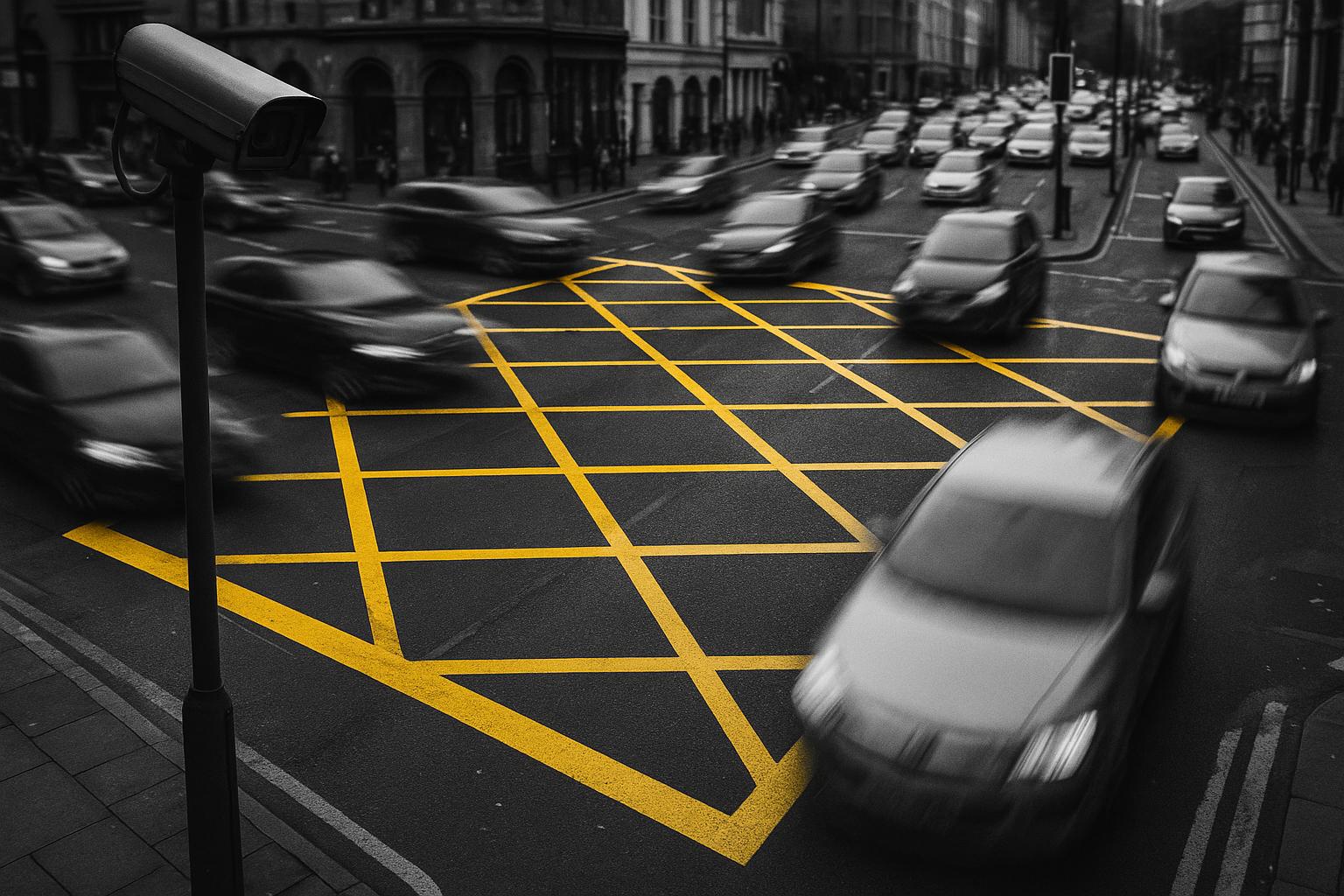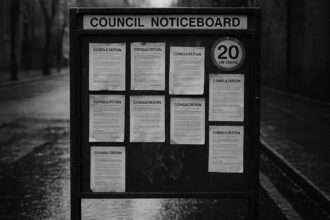Following new powers to enforce yellow box junction rules outside London and Cardiff, councils across England have issued over 32,000 fines totalling nearly £1 million in a year, prompting the RAC to demand updated government guidance to prevent unfair penalties and address design flaws.
Motorists across England have collectively faced nearly £1 million in fines from just 36 yellow box junctions in the past year, exposing the significant financial impact following new enforcement powers granted to local councils. This surge in penalty charge notices (PCNs) came after legislation introduced in May 2022 allowed councils outside London and Cardiff to issue fines for yellow box junction violations—a move that previously was limited to those two cities. The RAC, which obtained the figures via Freedom of Information requests, described the volume of fines as “enormously high,” suggesting it should “send alarm bells ringing in council offices.”
Yellow box junctions are specially marked areas designed to prevent gridlock by prohibiting drivers from entering the marked box unless their exit is clear or if they are waiting to turn right. This ensures traffic keeps flowing at busy intersections. The new data reports that 32,748 PCNs were issued outside London and Cardiff last year, generating £998,640 in fines, typically £70 with a reduced rate of £35 if paid within three weeks. Manchester City Council accounted for the majority of fines, with 13,130 issued across six junctions, bringing in almost half of the revenue. Medway Council in Kent and Buckinghamshire Council followed behind. Among individual junctions, the Dennis Roundabout in Guildford produced the highest single-site revenue, with over 4,200 PCNs amounting to more than £81,000 in fines.
While the financial totals are striking, the RAC raised concerns about potential misuse or unjust enforcement. Their analysis highlights that yellow box junctions generating only a small number of fines likely indicate proper functioning, whereas high volumes may signal that junction design or enforcement practices need review. Chartered engineer Sam Wright, commissioned by the RAC to analyse fines from London and Cardiff, found that 98 out of 100 boxes examined were significantly larger than necessary for their traffic management role—on average 50% bigger than needed—raising questions about fairness and efficacy.
The RAC has called for the government to update official guidance on the design, maintenance, and enforcement of these junctions to prevent drivers from being unfairly penalised due to poor planning or unclear road layouts. Research has shown many councils’ enforcement sites suffer from design flaws or contravene government guidelines, prompting calls for a thorough review to avoid drivers being caught out unfairly.
Some councils are defending their enforcement measures as necessary for reducing congestion and improving road safety. For example, Medway Council stated its approach is not aimed at “catching people out,” and that road markings have been updated to ensure visibility. Buckinghamshire Council noted that the volume of fines issued correlates with local congestion levels and driver behaviour. Meanwhile, local government representatives emphasised that fair appeal processes are in place for motorists who believe fines are unjust.
The expansion of enforcement powers is part of a broader national trend, with multiple councils preparing to introduce or already implementing camera enforcement at key junctions. Reading Borough Council started fining drivers for yellow box violations in early 2023, aiming to improve safety and air quality. Leicester City Council began preparations and in May 2024 initiated camera enforcement at two central junctions, with a warning phase preceding fines. However, the RAC has warned that the rapid rollout of enforcement powers, affecting nearly 40 councils, risks a surge in unfair fines, some potentially exceeding £100 for moving traffic contraventions—including yellow box offences—that were previously enforceable only by police outside London and Cardiff.
As councils gain increasing authority to penalise drivers for these offences, calls grow louder for clearer, updated government guidance and greater care in the placement and size of yellow box junctions. The RAC advocates for caution to ensure that such traffic management tools serve their intended purpose without unfairly penalising road users or becoming merely a source of local revenue.
 Reference Map:
Reference Map:
- Paragraph 1 – [1], [4]
- Paragraph 2 – [1]
- Paragraph 3 – [1], [4], [5]
- Paragraph 4 – [1], [4], [5]
- Paragraph 5 – [1]
- Paragraph 6 – [1], [2], [6], [7], [3]
Source: Noah Wire Services
- https://www.independent.co.uk/travel/news-and-advice/yellow-box-fines-law-pcn-b2776781.html – Please view link – unable to able to access data
- https://www.bbc.com/news/uk-england-berkshire-64707328 – In February 2023, Reading Borough Council implemented new rules to fine drivers who illegally stop in yellow box junctions. The scheme began with the Kings Road and Orts Road junction, and the nearby Kings Road and Eldon Road junction. Over the next six months, motorists blocking these junctions would receive an initial warning notice, with subsequent infringements resulting in a £70 penalty charge notice, reduced to £35 if paid within 21 days. The enforcement aimed to increase road safety and reduce congestion and poor air quality. ([bbc.com](https://www.bbc.com/news/uk-england-berkshire-64707328?utm_source=openai))
- https://www.telegraph.co.uk/news/2023/07/08/council-powers-rac-warns-of-surge-unfair-driving-fines/ – In July 2023, the RAC warned of a potential surge in unfair driving fines as nearly 40 councils were set to gain new powers to penalise drivers for moving traffic contraventions, including entering yellow box junctions. Previously, only the police could enforce such offences nationwide, with London and Cardiff being exceptions. The RAC urged drivers to be vigilant, as fines could exceed £100 for violations. ([telegraph.co.uk](https://www.telegraph.co.uk/news/2023/07/08/council-powers-rac-warns-of-surge-unfair-driving-fines/?utm_source=openai))
- https://media.rac.co.uk/pressreleases/rac-calls-on-government-to-update-guidance-on-yellow-box-junctions-to-avoid-councils-wrongly-issuing-fines-3172754 – In April 2022, the RAC called on the UK government to update its guidance on yellow box junctions to prevent councils from issuing fines incorrectly. With local authorities in England about to gain powers to enforce moving traffic offences, the RAC highlighted issues such as design flaws and poor maintenance of some junctions, which could lead to drivers being wrongly fined. The organisation urged the Department for Transport to improve its official design, maintenance, and enforcement guidance to councils. ([media.rac.co.uk](https://media.rac.co.uk/pressreleases/rac-calls-on-government-to-update-guidance-on-yellow-box-junctions-to-avoid-councils-wrongly-issuing-fines-3172754?utm_source=openai))
- https://www.autoexpress.co.uk/news/105295/councils-plan-unfair-yellow-box-junction-enforcement-fines – In May 2023, Auto Express reported that councils applying for new powers to enforce traffic offences at yellow box junctions risk fining drivers unfairly. An RAC investigation found that 90% of proposed enforcement sites had issues, with more than half directly contravening government guidelines. The RAC called for an urgent review of the Department for Transport’s guidelines to clarify what is enforceable. ([autoexpress.co.uk](https://www.autoexpress.co.uk/news/105295/councils-plan-unfair-yellow-box-junction-enforcement-fines?utm_source=openai))
- https://news.leicester.gov.uk/news-articles/2024/february/new-powers-will-see-council-tackle-moving-traffic-offences-at-key-junctions/ – In February 2024, Leicester City Council began preparations to enforce moving traffic offences at two key city centre junctions near St Margaret’s Bus Station. The council had gained permission from the Department for Transport to use camera enforcement at the junctions of Abbey Street and Gravel Street, and Vaughan Way and Causeway Lane. The new powers aimed to tackle traffic offences and improve congestion. ([news.leicester.gov.uk](https://news.leicester.gov.uk/news-articles/2024/february/new-powers-will-see-council-tackle-moving-traffic-offences-at-key-junctions/?utm_source=openai))
- https://news.leicester.gov.uk/news-articles/2024/may/new-camera-enforcement-powers-to-begin-at-key-city-centre-junctions/ – In May 2024, Leicester City Council announced the implementation of new camera enforcement powers at two key city centre junctions near St Margaret’s Bus Station. The enforcement aimed to penalise drivers for traffic offences at the junctions of Abbey Street and Gravel Street, and Vaughan Way and Causeway Lane. The cameras would operate 24/7, with an initial six-month warning period before issuing penalty charge notices. ([news.leicester.gov.uk](https://news.leicester.gov.uk/news-articles/2024/may/new-camera-enforcement-powers-to-begin-at-key-city-centre-junctions/?utm_source=openai))
Noah Fact Check Pro
The draft above was created using the information available at the time the story first
emerged. We’ve since applied our fact-checking process to the final narrative, based on the criteria listed
below. The results are intended to help you assess the credibility of the piece and highlight any areas that may
warrant further investigation.
Freshness check
Score:
8
Notes:
The narrative presents recent data on yellow box junction fines, with the earliest known publication date being 26 June 2025. The RAC’s findings were obtained via Freedom of Information requests, indicating original reporting. However, similar discussions have appeared in the past, such as the RAC’s call for updated guidance on yellow box junctions from April 2022. ([media.rac.co.uk](https://media.rac.co.uk/pressreleases/rac-calls-on-government-to-update-guidance-on-yellow-box-junctions-to-avoid-councils-wrongly-issuing-fines-3172754?utm_source=openai)) This suggests the topic has been previously covered, but the current report provides updated figures and insights.
Quotes check
Score:
9
Notes:
The report includes direct quotes from the RAC, such as describing the volume of fines as “enormously high,” suggesting it should “send alarm bells ringing in council offices.” These quotes appear to be original to this report, with no identical matches found in earlier material. This indicates potentially original or exclusive content.
Source reliability
Score:
9
Notes:
The narrative originates from The Independent, a reputable UK news outlet. The RAC, a well-known motoring organisation, is cited as the source of the data, further enhancing the reliability of the information presented.
Plausability check
Score:
8
Notes:
The claims about the high number of fines issued for yellow box junction violations are plausible and align with previous reports on the topic. The RAC’s concerns about potential misuse or unjust enforcement are consistent with earlier findings, such as their call for updated guidance on yellow box junctions from April 2022. ([media.rac.co.uk](https://media.rac.co.uk/pressreleases/rac-calls-on-government-to-update-guidance-on-yellow-box-junctions-to-avoid-councils-wrongly-issuing-fines-3172754?utm_source=openai)) The language and tone are consistent with typical journalistic reporting, and the report includes specific factual anchors, such as the number of fines issued and the councils involved.
Overall assessment
Verdict (FAIL, OPEN, PASS): PASS
Confidence (LOW, MEDIUM, HIGH): HIGH
Summary:
The narrative presents recent and original reporting on the high number of fines issued for yellow box junction violations, supported by direct quotes from the RAC and sourced from a reputable UK news outlet. The claims are plausible and consistent with previous reports on the topic, with no significant discrepancies or signs of disinformation identified.













